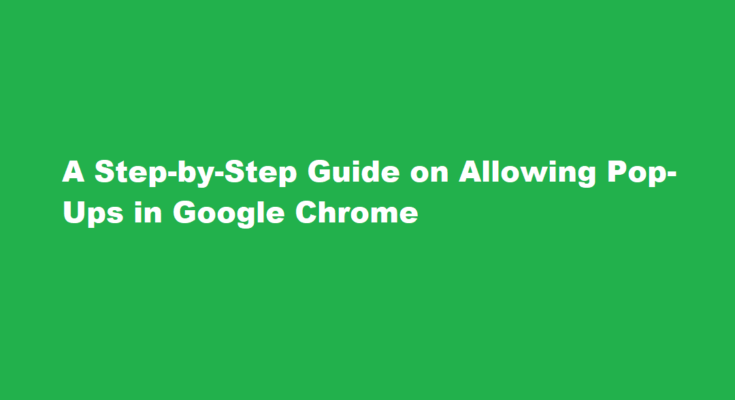Introduction
Google Chrome is one of the most popular web browsers globally, known for its speed, security, and user-friendly interface. However, it’s not without its quirks, and one common issue users encounter is dealing with pop-up windows. While pop-up blockers are essential for preventing intrusive ads and potential security threats, there are times when you may need to allow pop-ups for specific websites or functions. In this article, we will provide you with a step-by-step guide on how to allow pop-ups in Google Chrome while maintaining a secure browsing experience.
Why Allow Pop-Ups?
Before we dive into the “how,” let’s briefly discuss the “why.” Pop-ups can serve useful purposes. They may include login forms, online surveys, or important information from trusted websites. Blocking all pop-ups may hinder your browsing experience or prevent access to essential features on certain sites. Therefore, it’s essential to know how to selectively enable pop-ups when needed.
Launch Google Chrome
Start by opening Google Chrome on your computer. You can do this by clicking on its icon in your taskbar or by searching for “Google Chrome” in your computer’s search bar.
Access Chrome’s Settings
In the top-right corner of the Chrome window, you’ll see three vertical dots, which represent the “Menu” button. Click on this button to open a drop-down menu.
Navigate to Chrome’s Settings
From the drop-down menu, hover your mouse over “Settings” and click to open the Settings page.
Scroll Down to Advanced Settings
Scroll down the Settings page until you reach the “Privacy and security” section. Here, you’ll find an option called “Site settings.” Click on it.
Access Pop-Up Settings
Under “Site settings,” look for the “Pop-ups and redirects” option. Click on it to access the Pop-Up settings.
Toggle Off the Pop-Up Blocker
By default, Chrome’s pop-up blocker is enabled to block pop-ups. To allow pop-ups on specific websites, you’ll need to disable this feature temporarily. You’ll see a toggle switch next to “Blocked (recommended).” Click on the switch to turn it off.
Add Exceptions for Trusted Sites
With the pop-up blocker disabled, you can now add exceptions for trusted websites where you want to allow pop-ups. Under the “Allow” section, click on “Add” to add a site.
Enter the Website Address
A dialogue box will appear, asking you to enter the website address for which you want to allow pop-ups. Type the full web address (URL) of the site and click “Add.”
Confirm the Exception
The website you added will now appear under the “Allow” section. Confirm that the web address is correct, and Chrome will allow pop-ups for this specific site.
Test the Pop-Up
To ensure that pop-ups are now allowed on the selected website, visit the site and trigger a pop-up by clicking on a relevant link or button. You should see the pop-up window open without any issues.
Re-Enable the Pop-Up Blocker
Once you’ve finished allowing pop-ups for specific websites, it’s a good practice to re-enable Chrome’s pop-up blocker. To do this, simply go back to the “Pop-ups and redirects” settings, and toggle the switch back to the “Blocked (recommended)” position.
Frequently Asked Questions
How do I know if my pop-ups are blocked on Chrome?
If you visit a site that uses pop-ups and Chrome blocks the Pop-up window, you will see a notice in the Address bar: icon. This means Chrome has blocked the pop-up window from appearing. icon.
Does Chrome automatically block pop-ups?
Here’s how you can take control and allow or block pop-ups in Chrome. By default, Google Chrome disables pop-ups automatically in the browser; something easily overlooked because that’s how the internet should be presented. Not all pop-up windows are malicious or invasive. Some websites use them for legitimate reasons.
Conclusion
Allowing pop-ups in Google Chrome can be a straightforward process when you follow these steps. However, it’s crucial to exercise caution and only allow pop-ups on websites you trust. Pop-ups can be potential vectors for malware or phishing attempts on untrustworthy sites, so always be vigilant. By selectively enabling pop-ups for sites you know and need, you can strike a balance between a secure browsing experience and convenient access to essential web content. Remember to stay updated with Chrome’s latest features and settings, as they may evolve over time to better protect your online experience. Happy browsing!
Read Also : Mastering Alphabetical Sorting in Excel A Comprehensive Guide



